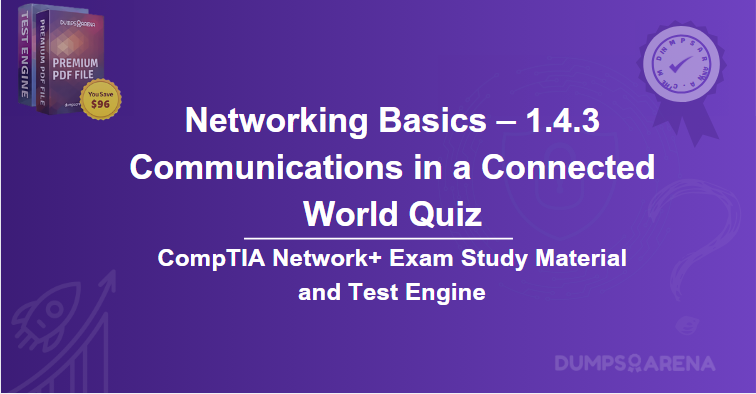Introduction
In the world of networking and data transmission, understanding the units of measurement for data transfer speeds is crucial. One of the most common questions in networking exams, including the CompTIA N10-008 certification, is: "What measurement is used to indicate thousands of bits per second?" The correct answer is "kbps" (kilobits per second).
This article will provide an in-depth explanation of data rate measurements, their significance in networking, their role in the CompTIA N10-008 exam, and how resources like DumpsArena can help aspiring IT professionals prepare effectively.
Understanding Data Transmission Rates
1. Bits vs. Bytes
Before diving into measurements, it's essential to distinguish between bits and bytes:
- Bit (b): The smallest unit of data (0 or 1).
- Byte (B): A group of 8 bits, typically used to measure file sizes.
Data transmission speeds are usually measured in bits per second (bps), while storage is measured in bytes (B).
2. Common Units of Data Transfer Rates
The following units are used to measure data transfer speeds:
- bps (bits per second) – Basic unit.
- kbps (kilobits per second) – 1,000 bits per second.
- Mbps (megabits per second) – 1,000,000 bits per second.
- Gbps (gigabits per second) – 1,000,000,000 bits per second.
Since kbps represents thousands of bits per second, it is the correct answer to the question.
Importance of kbps in Networking
1. Internet Speed Measurements
Internet Service Providers (ISPs) advertise speeds in Mbps or kbps. For example:
- A 100 kbps connection means 100,000 bits per second.
- A 10 Mbps connection means 10,000,000 bits per second.
2. Network Performance Monitoring
Network administrators use kbps to monitor bandwidth usage, troubleshoot slow connections, and optimize network performance.
3. Streaming and Downloading
- Low-quality audio streaming: ~96 kbps
- Standard-definition video: ~1,000 kbps (1 Mbps)
- High-definition video: ~5,000 kbps (5 Mbps)
Understanding these measurements helps in configuring Quality of Service (QoS) settings for better network management.
Role in CompTIA N10-008 Exam
The CompTIA Certification validates networking knowledge, including data transmission concepts.
1. Key Exam Topics Related to Data Rates
- Network Performance Metrics: Understanding kbps, Mbps, Gbps.
- Bandwidth vs. Throughput:
- Bandwidth: Maximum data transfer rate (e.g., 100 Mbps).
- Throughput: Actual data transfer speed (affected by latency, congestion).
- QoS (Quality of Service): Prioritizing traffic based on speed requirements.
2. Sample N10-008 Exam Question
Q: Which unit represents thousands of bits per second?
A) Mbps
B) kbps
C) Gbps
D) Tbps
Correct Answer: B) kbps
Such questions test fundamental networking knowledge, making DumpsArena’s CompTIA N10-008 practice tests invaluable for exam preparation.
Why DumpsArena is the Best Resource for CompTIA N10-008 Preparation?
1. High-Quality Exam Dumps
DumpsArena provides real Exam-like questions and answers, helping candidates familiarize themselves with the test format.
2. Detailed Explanations
Each question comes with in-depth explanations, reinforcing key concepts like kbps, Mbps, latency, and bandwidth.
3. Updated Study Material
The platform ensures up-to-date content aligned with the latest N10-008 exam objectives.
4. Practice Tests for Self-Assessment
Simulated exams help identify weak areas, allowing focused study.
5. Positive Reviews from Certified Professionals
Many successful CompTIA Network+ certified individuals credit DumpsArena for their success.
Conclusion
Understanding kbps (kilobits per second) is fundamental in networking, especially for the CompTIA N10-008 exam. This unit measures thousands of bits per second and plays a crucial role in internet speeds, network performance, and QoS configurations.
For those preparing for the CompTIA Network+ certification, DumpsArena offers reliable exam dumps, practice tests, and detailed explanations, making it a top choice for aspiring IT professionals.
By mastering these concepts and leveraging DumpsArena’s resources, candidates can confidently pass the N10-008 exam and advance their networking careers.
Get Accurate & Authentic 500+ CompTIA N10-008 Exam Questions
1. What unit is used to measure thousands of bits per second?
A) Hertz (Hz)
B) Kilobits per second (Kbps)
C) Megabytes per second (MBps)
D) Gigabytes per second (GBps)
2. How many bits per second are in 1 Kbps?
A) 100 bits per second
B) 1,000 bits per second
C) 1,024 bits per second
D) 8,000 bits per second
3. Which of the following is a correct representation of kilobits per second?
A) KBps
B) kbps
C) Kb/s
D) Both B and C
4. What is the difference between Kbps and KBps?
A) Kbps measures speed, KBps measures storage
B) Kbps is kilobits per second, KBps is kilobytes per second
C) They both mean the same thing
D) Kbps is for audio, KBps is for video
5. If a download speed is 256 Kbps, how many bits per second is that?
A) 256 bits per second
B) 2,560 bits per second
C) 25,600 bits per second
D) 256,000 bits per second
6. Which of the following is faster?
A) 512 Kbps
B) 1 Mbps
C) 100 Kbps
D) 256 Kbps
7. In data communications, Kbps is typically used to measure:
A) File size
B) Network bandwidth
C) Screen resolution
D) Processor speed
8. How many Kbps are in 1 Mbps?
A) 100 Kbps
B) 1,000 Kbps
C) 1,024 Kbps
D) 8,000 Kbps
9. Which of the following is NOT a unit of data transfer rate?
A) Kbps
B) Mbps
C) Gbps
D) GHz
10. Why is Kbps commonly used instead of bps in networking?
A) Because it represents larger, more practical speeds
B) Because bps is too small for most applications
C) Because Kbps is the standard set by the IEEE
D) Both A and B



